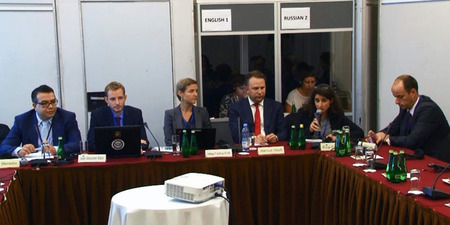The panel debate took place in Warsaw, where representatives of 57 states, partners, civil society and international organisations were gathered for the Organization for Security and Co-operation in Europe’s (OSCE) Human Dimension Implementation Meeting 2015.
Increased risk of torture and inhuman treatment
Some people are at greater risk than others of torture and inhuman treatment during deprivation of liberty. This could be due to their age, gender, ethnicity, religion, sexual orientation or health situation. How can the rights of such people be better safeguarded?
First, Jean-Sébastien Blanc of APT spoke about risk factors and challenges for detainees in particularly vulnerable situations in general.
Then Idaver Memedov of the OSCE described challenges in the relationship between Roma and Sinti groups and the police in the OSCE area.
Yuri Belousov, head of the Ukrainian National Preventive Mechanism, spoke about the particular vulnerability of children deprived of their liberty.
See videos of these presentations at the APT website.

Experience of gender-sensitive preventive work in Norway
Helga Fastrup Ervik, head of the Parliamentary Ombudsman’s National Preventive Mechanism (NPM), gave a speech about the experience of gender-sensitive preventive work in Norway.
She explained that women in Norwegian prisons are generally a marginalised group, since there are only three women-only prisons in Norway. Female inmates mostly serve their sentences in prisons where the majority of the inmates are male.
She also explained how the NPM prepares for and carries out prison visits as regards gender sensitivity. Among other things, the NPM ensures that the team of visitors is gender-balanced and that they have access to both male and female interpreters, and they try to ask the right people the right questions. Not least, flexibility is emphasised so that the NPM team can accommodate wishes and facilitate good dialogue with the people they talk to during the visit.
Findings from visits to Norwegian prisons
Ervik stated that many Norwegian prisons have separate units for women. At the same time, there is a small number of female inmates in each prison, sometimes as few as one or two. In order to ensure that the women and men are kept separate, the female inmates are often placed in restricted units and thus serve under a stricter security regime than they should.
Also, women often serve their sentences in prisons far away from their home.
The NPM has also found that some women feel unsafe, even in separate units. One possible reason is that the prison staff do not spend as much time in the women’s units. Female inmates also have fewer activities and smaller outdoor areas available to them. The lack of activity can cause a lot of frustration.
Transgender persons are often very isolated, and sometimes they choose to serve their sentence in a restricted unit because they feel unsafe in prison.
See a video of Ervik’s speech in full below.
Experiences of gender-sensitive detention monitoring (Helga Fastrup-Ervik, Head of the Norwegian NPM) from APT Geneva on Vimeo.